Racinaea tetrantha
Click thumbnails for full size, scaled to a new window.
Racinaea tetrantha var. aurantiaca
Please check the complete discussion that follows.
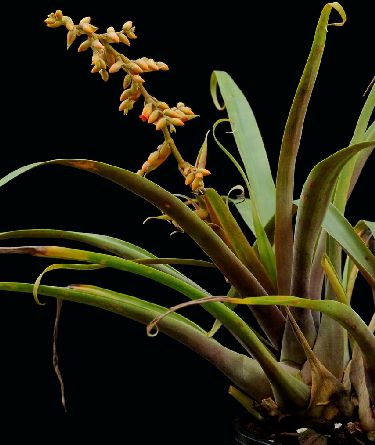
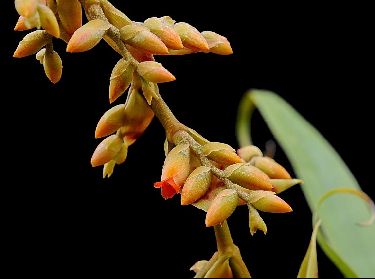
Peter Tristram 28/03/12
After many attempts I think I finally have a Rac. tetrantha (var. aurantiaca in this case) that is easy to grow. It has taken months for the inflorescence to develop but worth the wait.
Racinaea pseudotetrantha
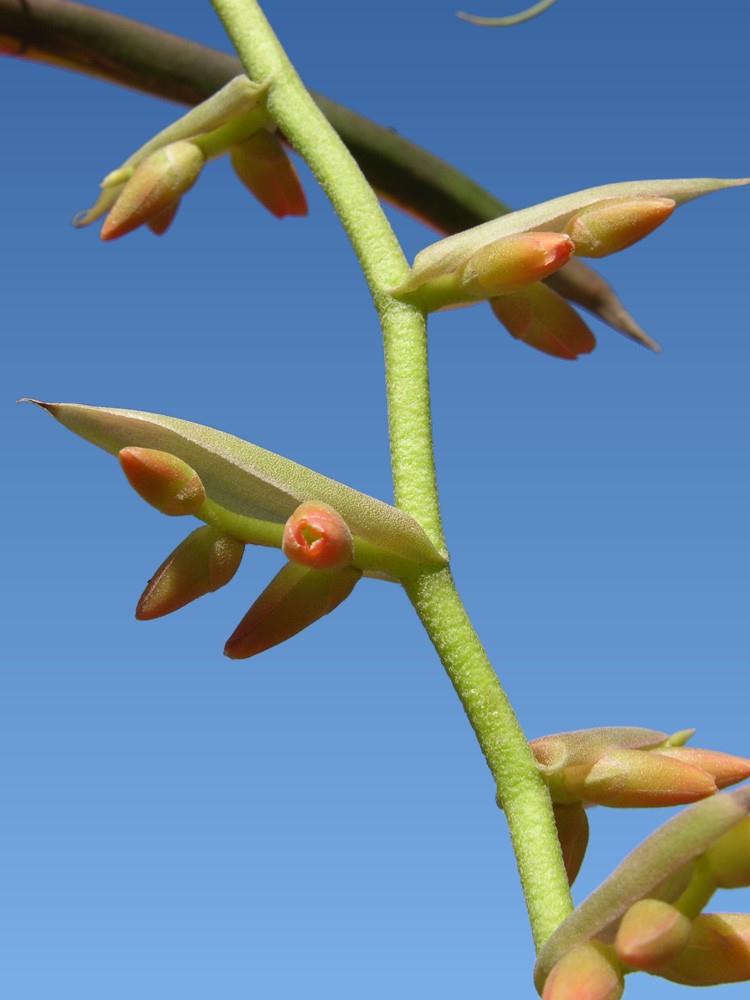
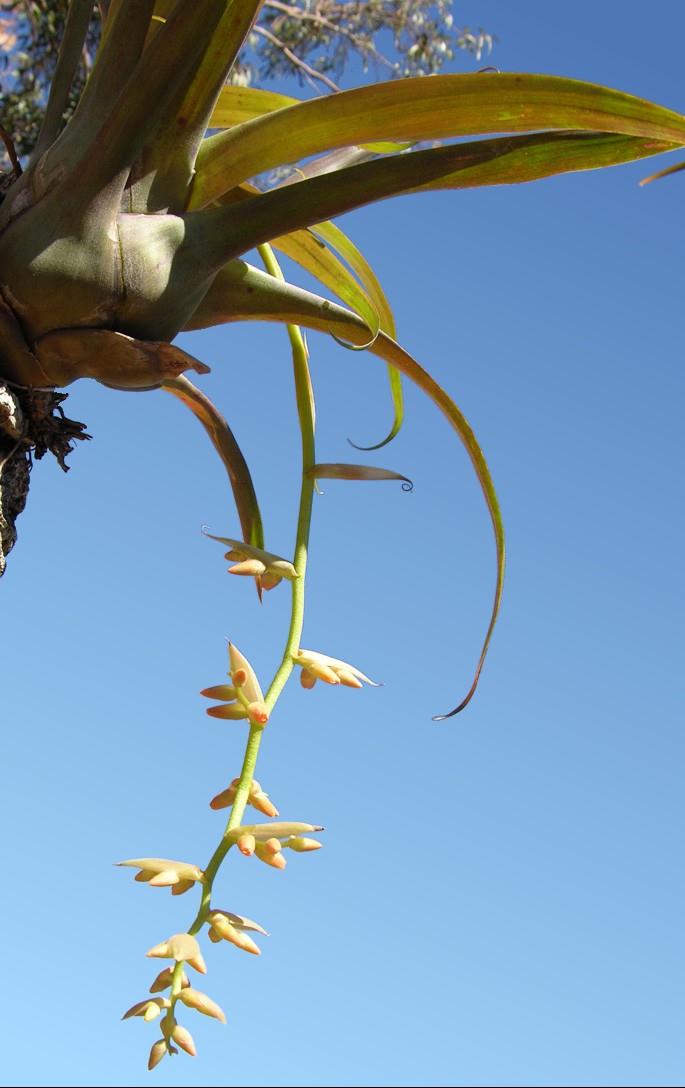 Len Colgan 29/03/12
Len Colgan 29/03/12
Peter: Well done! Of the eight Racinaea tetrantha plants I brought back from Ecuador (from different locations, including different forms), only one still survives. However, my Racinaea pseudotetrantha is going gangbusters! My mate in Ecuador told me it is a lot easier to grow than any of the forms of R. tetrantha.
Are you 100% sure your plant is not R. pseudotetrantha? Eric Gouda wanted to know where I had collected R. pseudotetrantha, and so it is possible it is rarer. I don't know.
Racinaea tetrantha var. aurantiaca
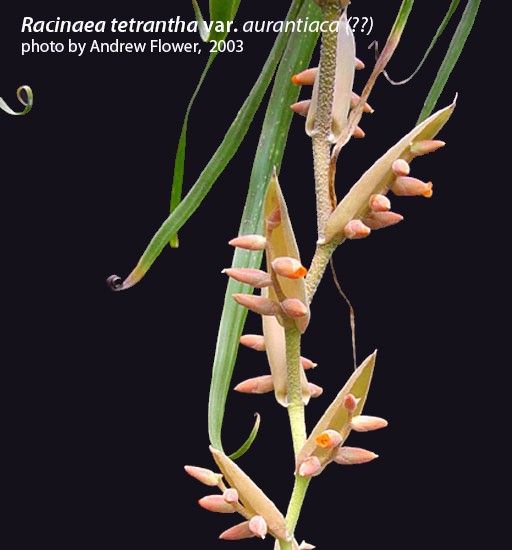
 Andrew Flower 30/03/12
Andrew Flower 30/03/12
Len: Must admit I wonder about Peter's plant too... it doesn't seem to fit with the Racinaea tetrantha var. aurantiaca I have been growing: for one thing its spike is going up cf., ours are always pendant, and for another thing the primary bracts seem mainly shorther than the spikes whereas on my plants (and the herbarium specimen - see Unc's DVD) - the primary bracts are longer than the spikes per attached pics. Perhap's Andre's herbarium specimen is upside down, too?
Further research gets confusing. The description of v. aurantiaca in S&D says the primary bracts are "often" shorter than the spikes, and the scape bracts are "mostly" shorther than the internodes, whereas on our plants the scape bracts are 5-6 times longer than the internodes. If you turn Andre's herbarium specimen (which, incidentally, he named Tillandsia aurantiaca var. genuina) upside down, it does seem close to our plant.
Our plants of v. aurantiaca descend from seed sent to me by Ken Woods in 1996 - it would be helpful to get some idea of how true to label they are - particularly as I think I have in the past sent seed from them to Bob so they have probably been distributed around in Australia again.
Do you have photos of your pseudotetrantha in flower?
Len Colgan 31/03/12
The plants were collected in the area specified in the description, and my companion was adamant it is R. pseudotetrantha. He said it was easier to grow than any form of R. tetrantha. That is at least certainly true!
These are the only two pictures I took of Racinaea pseudotetrantha. Note that there is a distinct reddish hue in the lower leaves, for all that might be worth.
Derek Butcher 30/03/12
Andrew: I thought Pedro's plant 'looked' OK but then Len came up with his query and I looked at what Harry had to say in 1990 about his pseudotetrantha. I quote....
Type: Ecuador: El Oro. 11 km W of Pinas. road to Sta, Rosa (?new road"), 850 m elev., 8 Oct. 1979. Dodson, Gentry, and Shupp 9075 ( Holotype SEL.).
This new species is most closely related to Tillandsia tetranthra R & P. but differs by its more exserted sepals that are only slightly asymmetrical, paler leaf sheaths, narrower, more flexible leaf blades and cinereous lepidote inflorescence.
I then looked at
Key to the Varieties of Racinaea tetrantha
1. Floral bracts minute or wanting; inflorescence lax, pendulous; spikes lax. --> var tetrantha
- about half as long as the sepals. --> 2
- about as long as sepals, Inflorescence bipinnate --> var caribaea
2. Inflorescence bipinnate. --> 3
2. Inflorescence tripinnate. --> var ramosior
3. Primary bracts orange to dark brown, often shorter than the spikes. --> 4
3. Primary bracts bright red or rarely pale greenish yellow, exceeding the spikes. --> 5
4. Inflorescence elongate, lax with lax spikes; scape-bracts mostly shorter than the internodes. --> var aurantiaca
4. Inflorescence short, dense; scape-bracts imbricate. --> var densiflora
5. Leaves coriaceous, firm; inflorescence elongate, lax. --> var scarlatina
5. Leaves soft, flexible; inflorescence mostly small, compact. --> var miniata
Now, pseudotetrantha floral bracts are said to be half the length of the sepals so where are they more exserted. Leaf blades are said to be 1-2cm but Len's are wider than that. Regrettably I cannot say if they are more flexible. We don't know if Len's plant had grey lepidotes or even what applies to all of the other varieties. We know that Len's inflorescence is pendent but this is not defined in the description which says to me it can be erect OR pendent.
Regrettably we don't have photographs of what taxonomists treat as v. aurantiaca but there are several of these paratypes listed under this variety with one marked transitional to the type.
Therefore we can only go so far in our identifications. Perhaps R. pseudotetrantha would have been better described as a variety of R. tetrantha.
Peter Tristram 30/03/12
I wondered about pseudotetrantha too (as in why isn’t it just another tetrantha??).
I think this plant could well be from Halle (awaiting confirmation) where the control climate produces magnificent Racinaea specimens (see dvd). My plant has very dark sheaths too.
Andrew Flower 31/03/12
Len, the immediate question is: what significant difference do you see between this and the plant we have been growing as v. aurantiaca in the photos I posted?
Derek didn't directly address this aspect of my previous post, but I think that the plant we are growing is from Ken's seed and the plant in Andre's upside-down herbarium specimen at NY Bot Gardens are one and the same, and do not tally with the description of v. aurantiaca by L.B. Smith.
Peter Tristram 31/03/12
Len: Now that matches the description of pseudotetrantha better with those barely exposed petals and greener-looking leaf sheaths and the long pb exceeding the branches. Your plant and Andrew’s are very similar. Are those leaves soft and flexible? The ones on my plant are leathery and pliable and the sheaths are very dark. I’ll post the pics, with other details, on florapix for the taxonomists to check out.
Len Colgan 31/03/12
The leaves are soft and flexible.

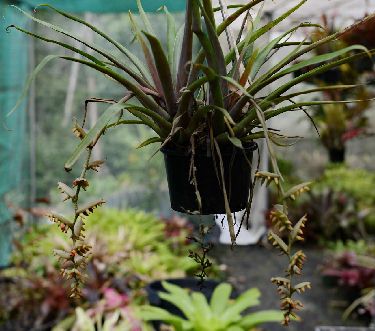
Peter Tristram 09/14 ... "I grow this one outside in the shade of the shed’s roof – Rac. tetrantha v. aurantiaca (what I purchased it as) or pseudotetrantha has also been suggested but I favour the non-imposter! lol. It bloomed earlier in the year. Chris and I searched in vain for seed of that lovely form near El Cairo in Colombia (posted in early August), so I guess this one I got from Germany will have to do. I had others (as did Len ex Ecuador I think) but they all died."
Updated 05/10/14





